At a Glance
- Building inclusive teams improves performance and is the right thing to do. It also pays off in recruitment, retention, and better teamwork.
- People describe what being included looks and feels like in remarkably similar ways.
- Helping everyone feel included is deceptively difficult, but organizations can navigate the complexities by marrying systemic change with more inclusive behaviors.
- Across all groups, a common thread is the desire to grow and succeed. But organizations can pinpoint additional specific steps that will improve inclusion by looking at their population through the lenses of demographics, geography, and seniority.
- There’s no quick fix, but getting started—testing and learning, prioritizing the actions and populations that most need support, and demonstrating commitment—produces immediate value.
We all know what it feels like to belong somewhere—to be included—and naturally, we want all team members in our organizations to feel that way. We all know intuitively that this is the right way to run an organization; we also know from neuroscience that when people feel excluded, it sets off biological alarms in the brain resembling those associated with physical pain—not something conducive to employee well-being and performance.
Besides being the right thing to do and stimulating better individual and team performance, building inclusive teams pays off handsomely for companies by helping them attract and retain the most diverse and talented employees. Despite the clear benefits, however, most companies struggle to foster feelings of inclusion for the majority of their people.
It is hardly surprising that organizations find it difficult to determine which specific changes they must make to promote greater inclusion for their diverse employee bases. So we at Bain & Company surveyed 10,000 individuals—across diverse industries and demographic backgrounds, in seven countries, at all levels of seniority and organizational size—to learn what actually makes employees feel the most included. One of our first and most stark takeaways is that most employees, regardless of race, gender, or sexual orientation (including straight white men), don’t feel fully included.
The good news is that, despite all the noise in the organizational world around what inclusion really means, it turns out that most people, regardless of their identities and experiences, describe what being included looks and feels like in remarkably similar ways. Our view, backed by data, is that the experience of inclusion is almost universal and has a few distinct components that people—across populations—find important. Asked to describe what an inclusive organization looks like, the wide range of individuals we surveyed converged on these points: An inclusive organization is one that is diverse and in which people are heard, valued, and supported (see Figure 1).

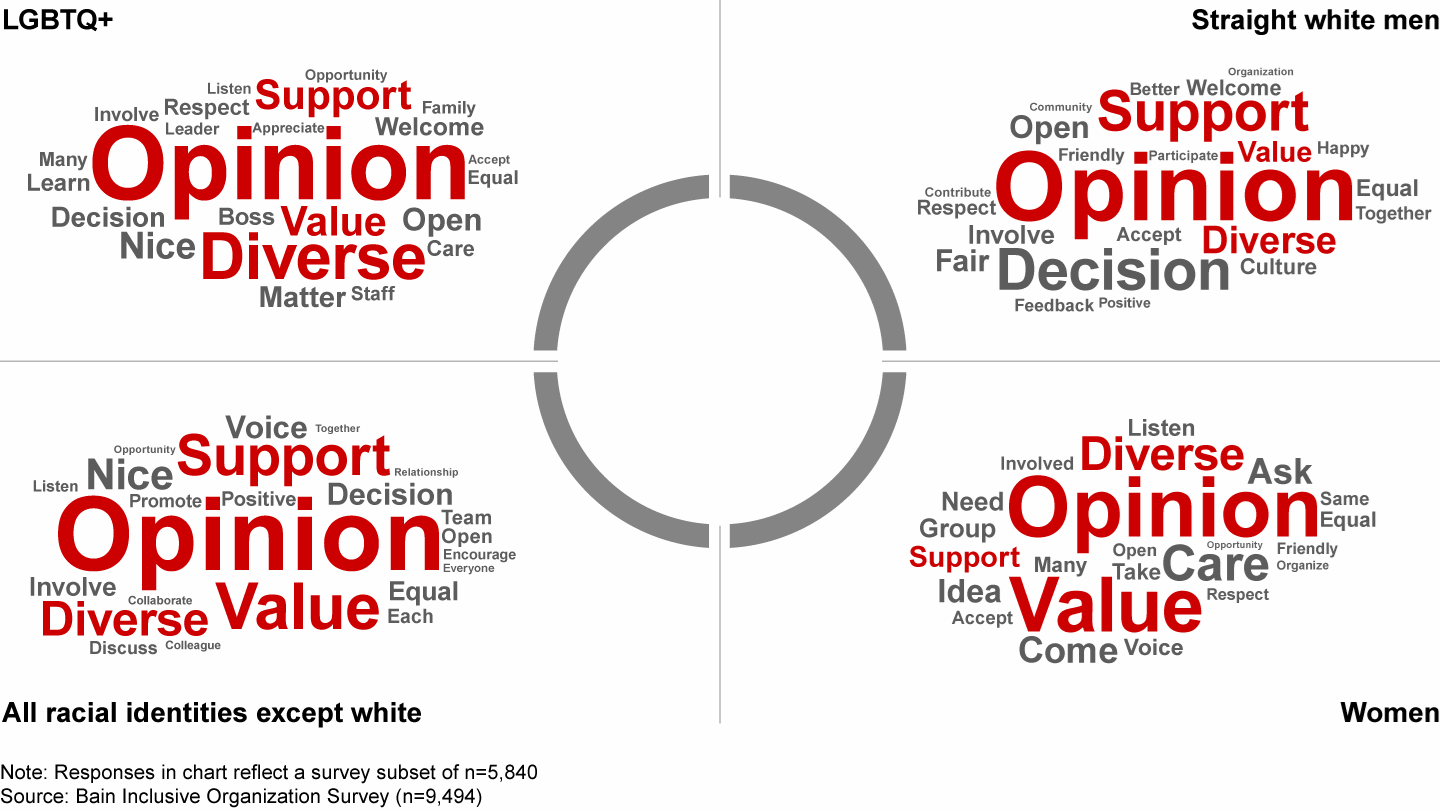
When asked what inclusion feels like, employees across all demographics say it is being treated with dignity, able to bring their authentic selves to work, able to contribute, and feeling connected to others—which is our definition of inclusion.
We define inclusion as the feeling of belonging in your organization and team, feeling treated with dignity as an individual, and feeling encouraged to fully participate and bring your uniqueness to work every day.
How an organization helps all its people feel included in these ways, however, gets complicated. Rigorous analysis of our data has also shown us that the specific paths to that universal sense of inclusion are unique to an individual’s identity—an identity that is informed, of course, by a variety of factors including not just race or ethnicity, gender, and sexual orientation, but also geographic location and level in the organization.
Even so, there are ways to navigate these complexities and identify concrete actions that can help an organization foster higher and more widespread inclusion—unlocking the full set of benefits that diversity can bring. Our research has found that the enablers of inclusion are highly textured and varied across every population, but that this heterogeneity can be addressed by combining systemic change with more inclusive behaviors.
This raises an obvious question: Which specific enablers and combinations of enablers matter, and to whom, and how can companies identify and take the actions that will actually bring about change? In this report, we share what our research tells us about the answers, turning first to the larger question lying behind all these other ones: What is the value at stake in creating more inclusive organizations?
Why inclusion matters
Many companies today pursue diversity by itself as a priceless asset. But our research shows that they cannot realize and sustain the full value of that diversity—enabling diverse talent to thrive, fully contribute, progress, and want to stay—without a truly inclusive culture. Organizations understand that having a diverse workforce pays off—or should pay off—by stimulating innovation and challenges to the status quo from different points of view. But the only way to realize these and other benefits of diversity is to continuously progress toward a more inclusive environment for all team members.
Inclusive organizations have an easier time attracting talent across demographics: Approximately 65% of people across identity groups view an inclusive environment as “very important” when considering new roles. But recruiting a diverse group of employees is only the beginning. A truly inclusive environment is critical for retention and provides a variety of other tangible, measurable benefits. Our research finds, for example, that employees experiencing low inclusion are up to six times more likely to actively pursue new jobs compared with those in similar demographics experiencing high inclusion. It also shows that those who feel “fully included” are much more likely to promote their place of employment to others (+71% vs. –83%, using Bain’s employee Net Promoter Score℠ methodology of calculating the percentage of promoters minus the percentage of detractors) than those who feel “not at all included” (see Figure 2).
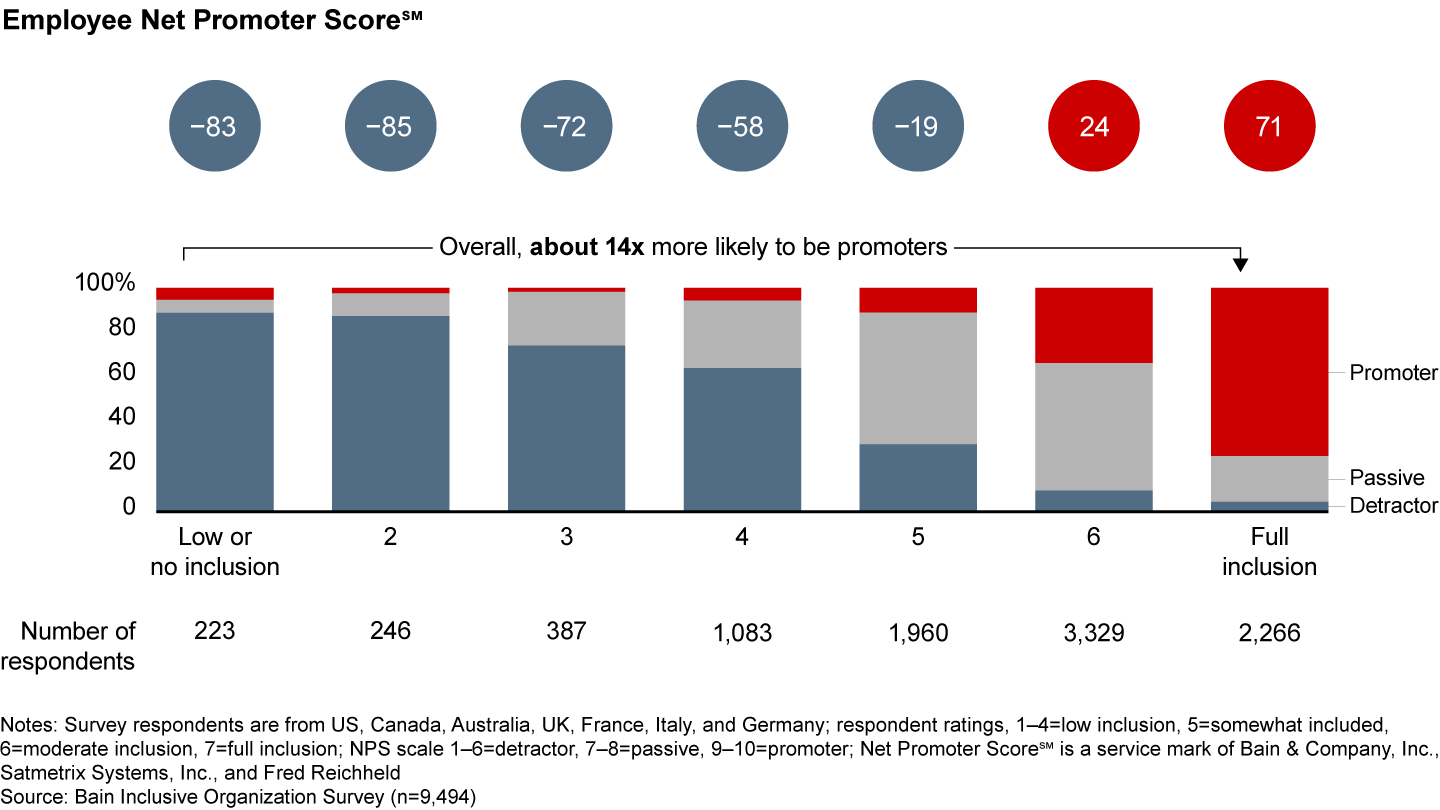
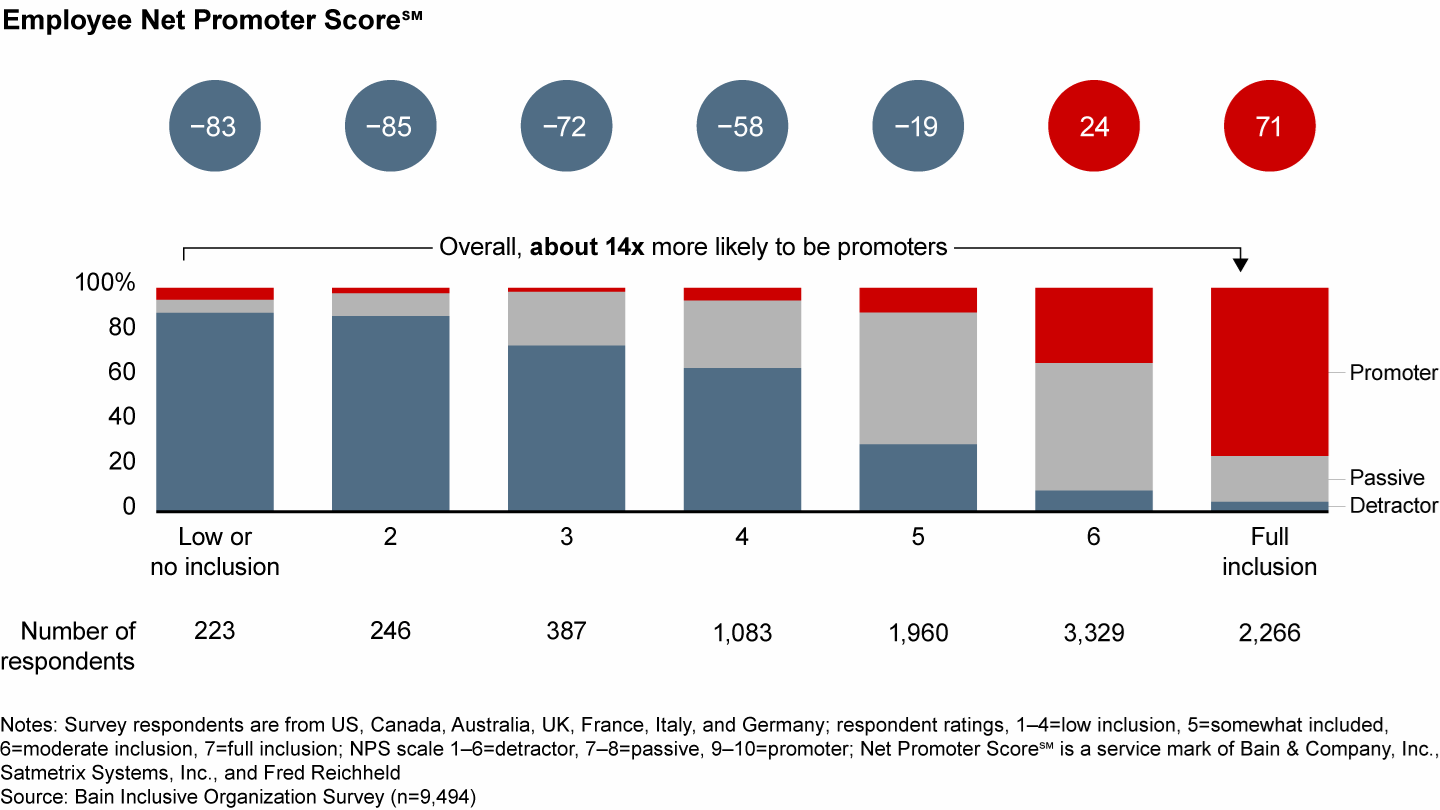
Our research also finds that respondents in a more inclusive organization are much more likely to feel free to innovate and to feel comfortable challenging the status quo—and that the gains in creative thinking are much higher as inclusion increases in an organization, compared with the gains from increasing diversity alone. Respondents who viewed their organizations as both diverse and inclusive were the most likely to feel comfortable bringing new ideas to the table (see Figure 3).
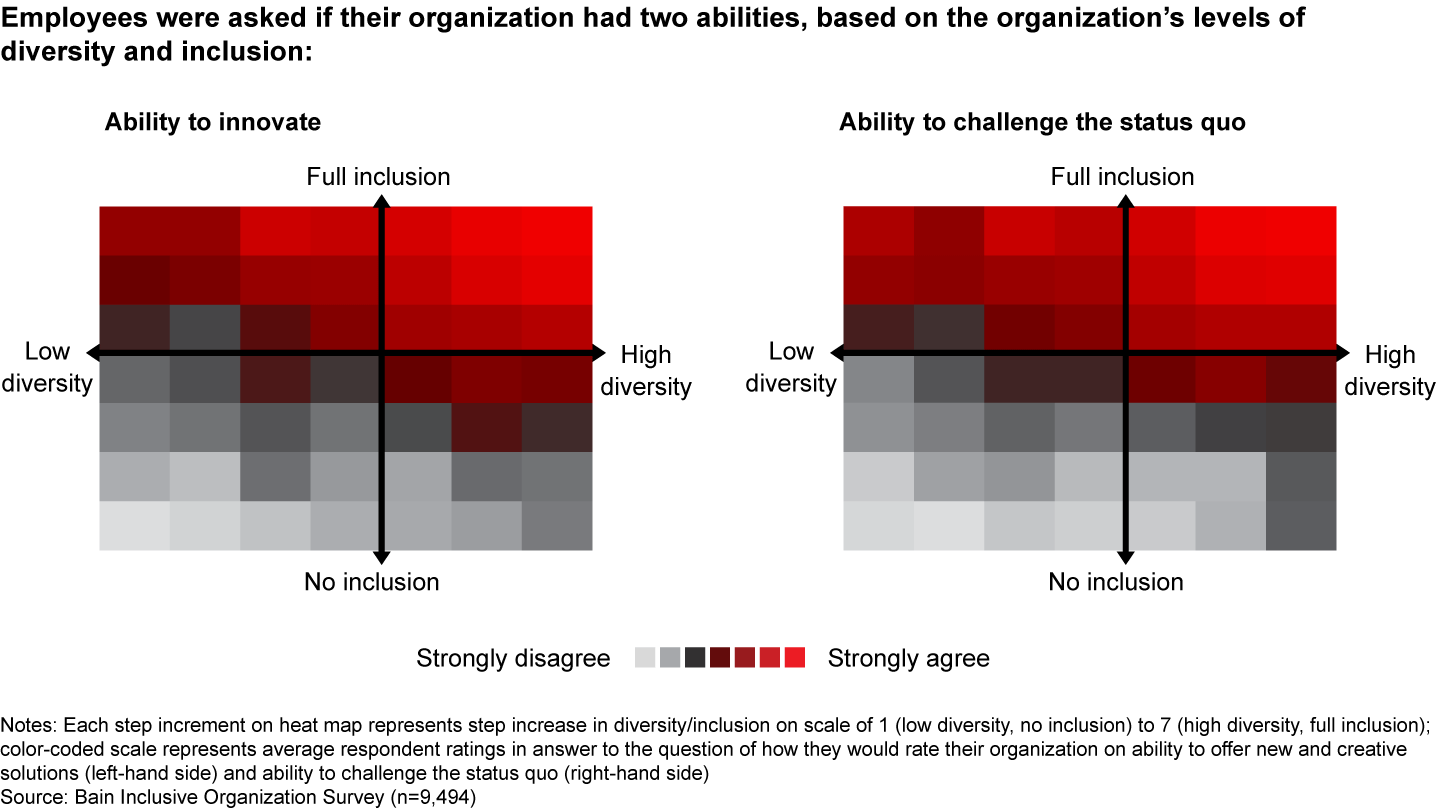

To truly maximize retention, performance, innovation, and comfort in challenging conventional thinking, organizations should aim for both diversity and inclusion. But while diversifying a workforce can take time, there are tangible benefits to working on inclusion immediately, even if an organization isn’t currently as diverse as it could be.
Fostering inclusion is deceptively difficult
Although everyone wants to build inclusive organizations, few (if any) companies have “cracked the code” for consistently fostering inclusion for employees. There are several reasons for the difficulty of creating truly inclusive companies:
You can’t easily predict who feels excluded. According to our research, fewer than 30% of employees feel fully included—a finding that holds across industries, geographies, and demographic groups, including members of racial, gender, or sexual orientation majorities. No single demographic variable pertaining to race, gender, or sexual orientation cleanly “predicts” lower levels of inclusion in companies, and underrepresented groups do not report feeling significantly less included than majority groups (e.g., straight white males in the US, Canada, Australia, and Western Europe) (see Figure 4). The reasons why people may feel excluded can vary based on context and identity, but the end result is that everyone can and does feel excluded at points.
“I definitely have felt excluded, especially when my manager was not straightforward about what I needed to do to be promoted. They were stringing me along, and there’s no dignity in being treated like that.”
“I’m a white male, and at times I’ve felt excluded when I brought ideas to my coworkers who didn’t take them seriously or criticized them.”
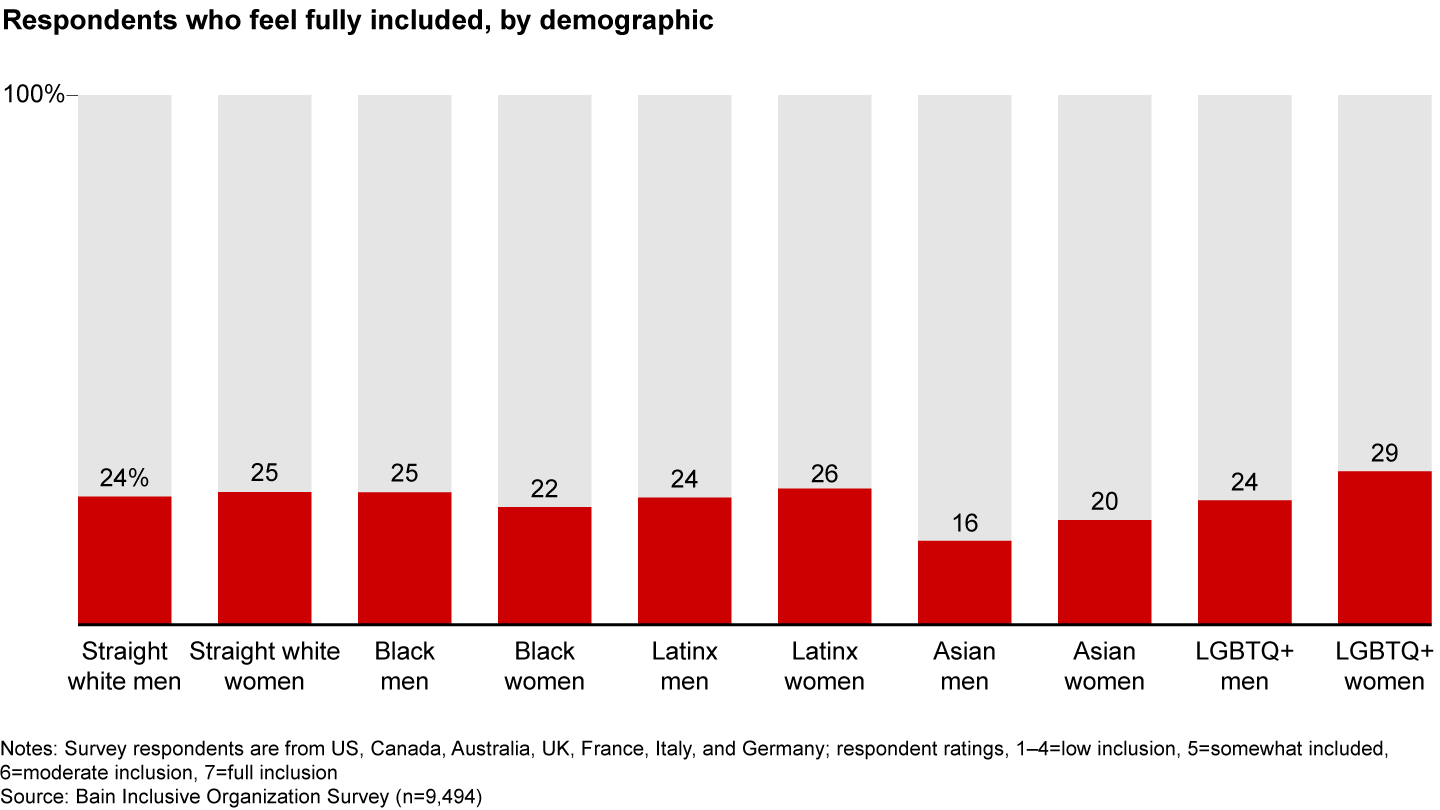

Like all of us, senior leaders responsible for making change often have “blind spots” and can be unaware of challenges around inclusion in their workplaces. This is natural given that people experience behaviors and systems in their organizations in different ways.
Today’s senior leaders have succeeded and risen in existing cultures and systems, and often come from the very majority groups that design and sustain them. While they do often recognize that people from other groups have experiences different from their own, they can struggle with how to respond.
“I think all the roles are available officially, but I don’t think we get chosen equally for the roles. If you were liked, you were in, but most of the time, people of color don’t get selected.”
“I know that diversity is good, and I absolutely want everyone to feel they have a seat at the table . . . but what does a straight, white, married man understand about diversity, equity, and inclusion?”
Leaders who are members of majority groups may also gravitate to narrow, behavior-focused solutions such as “acting nicer” or giving employees more opportunities to socialize, or they may rely heavily on team members belonging to underrepresented groups to tell them what they should do—which both increases the burden on those groups and assumes they bring the requisite knowledge of how to advance inclusion.
We all want more inclusive environments, but have different views about how to get there. Employees in every demographic rate inclusion as a critical factor in selecting an employer, but interviews reveal that people have their own deep-seated beliefs about what inclusion means—beliefs that can clash in ways that bring about deep discomfort. For example, for many employees—particularly those from majority groups—adjusting systems to create a more inclusive environment can cut against fundamental, deeply held ideas about fairness, equality, and meritocracy. Many efforts to improve inclusion require an appreciation of the idea of equity as opposed to equality—i.e., addressing the unique needs of particular populations rather than “treating everyone the same.”
“If you want me to feel included, foster an environment where people judge me for the quality of my work and acknowledge and respect my uniqueness.”
“Other companies try these programs to make things more inclusive for one group but not another, and it ends up making the whole place less inclusive. You should just treat everybody the same.”
Every demographic population has a unique “texture” when it comes to enablers of inclusion. Even though the feeling of inclusion is fundamentally the same across groups, our research shows that the lived experience of inclusion is driven for various groups by a diverse variety of factors. In our research, we tried to determine which of a wide range of organizational enablers of inclusion—which we broadly classify as “behavioral” and “systemic”—were most effective in making people feel included (see Figure 5). To do this, we ran thousands of regressions across populations to understand what really increases feelings and experiences of inclusion across many distinct populations.
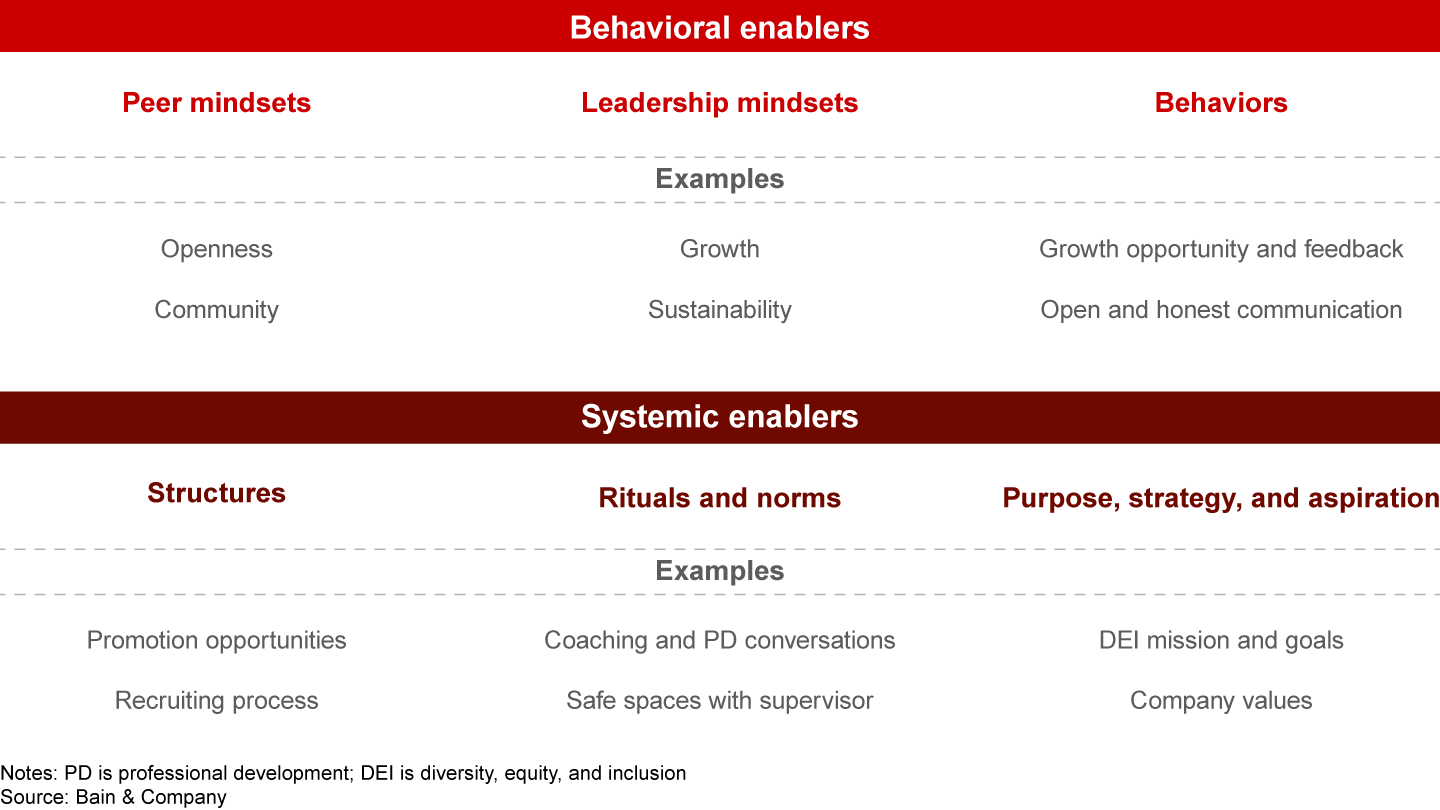
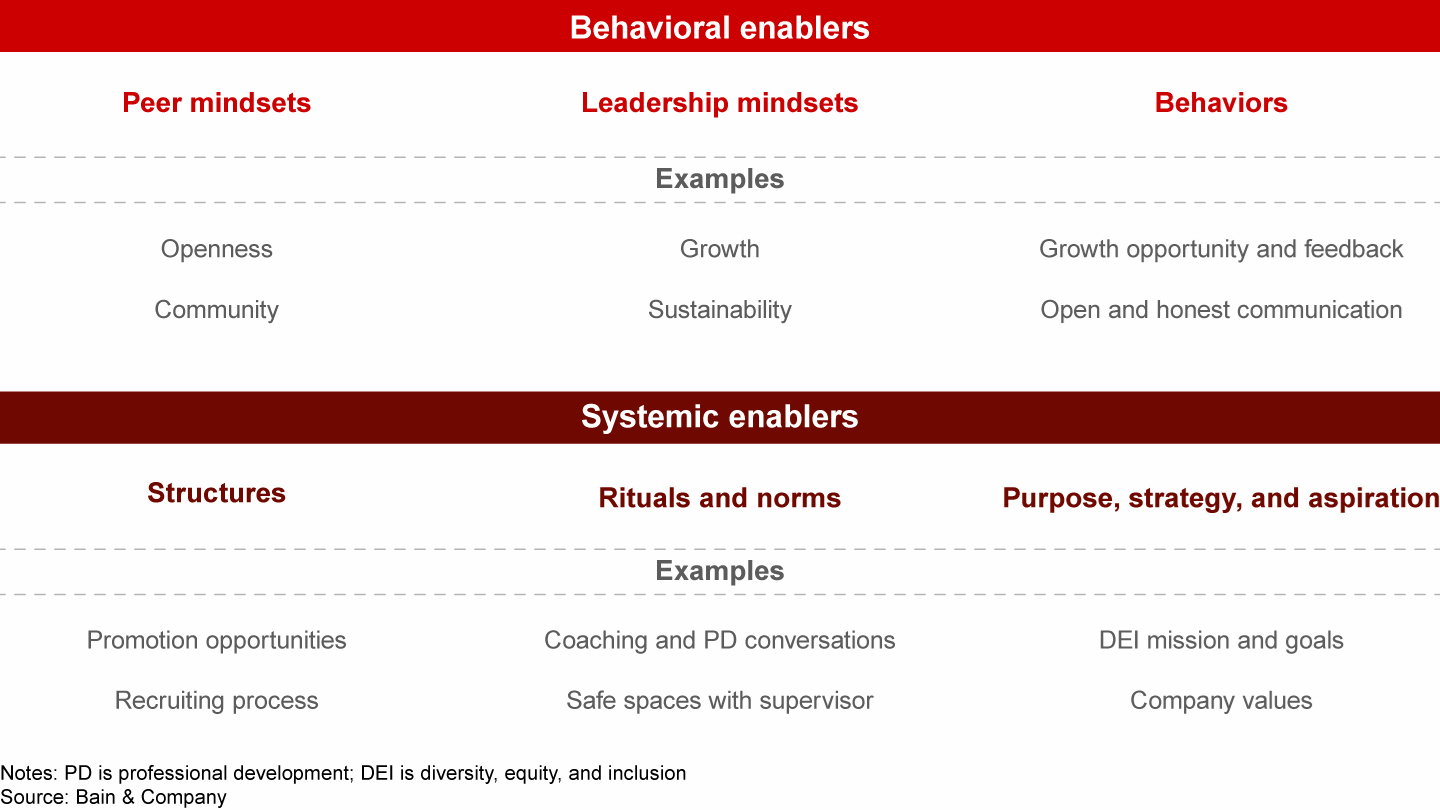
Every employee’s sense and experience of inclusion benefited from both behavioral and systemic enablers, but the mix of effective enablers—what we might call the texture of inclusion—varied across groups with respect to identity, geography, and level within their companies (see Figure 6).
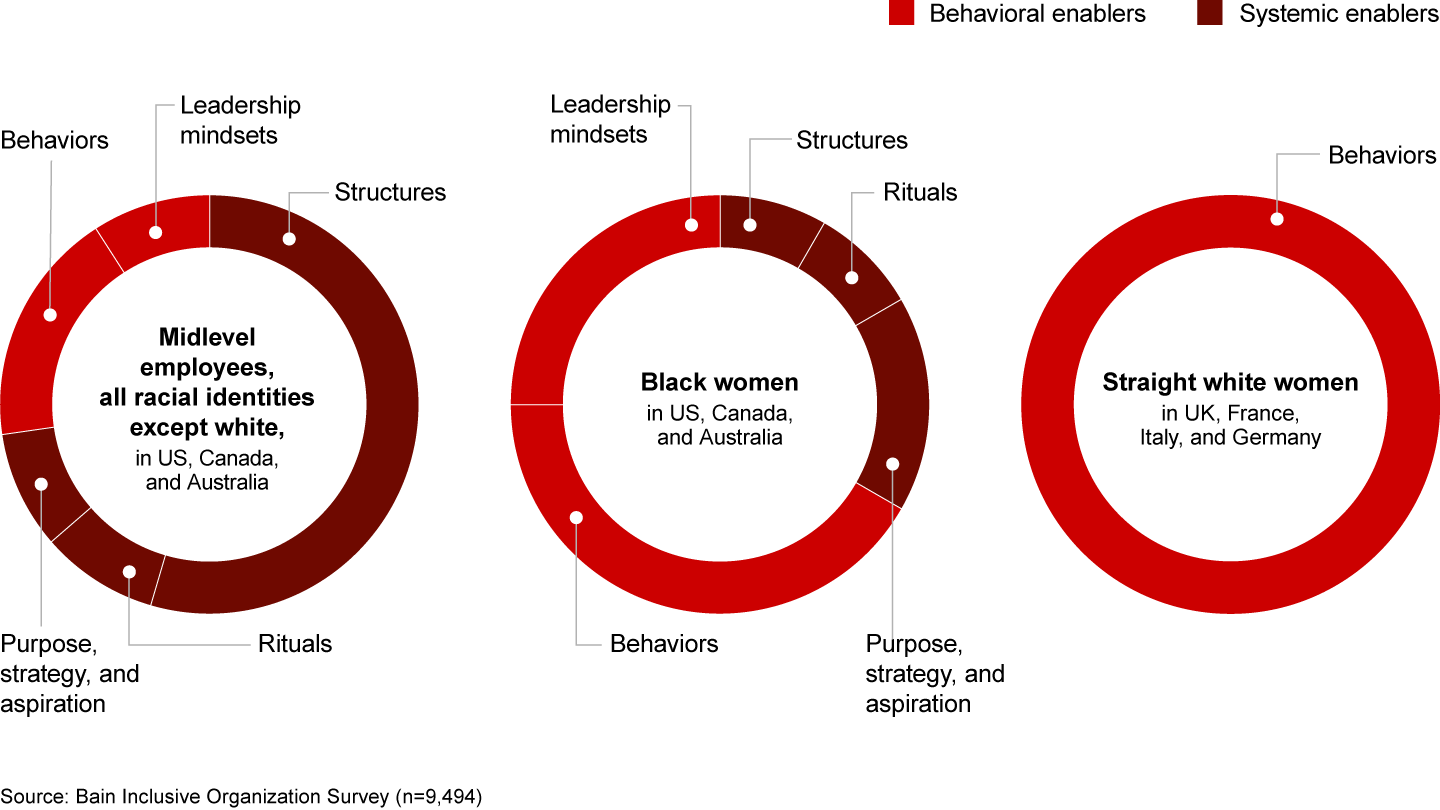

People do not always know what enablers will most increase their own experiences and feelings of inclusion. We found that for many populations, the perceived impact and actual benefit of particular enablers can be mismatched. In reality, people have not always seen or directly experienced “what good looks like,” and may not be fully aware of which enablers will actually increase their feelings of inclusion, even for themselves. When we looked, for example, at the responses of Black women, we found that coaching and professional development did more to increase their sense of inclusion than other enablers that they ranked higher in perceived value (see Figure 7). The larger point across all populations: Leaders should listen first for problem identification, not solution design.
“What makes me fully included? . . . It’s kind of alarming, but I don’t know, and I need to think about it for a moment.”
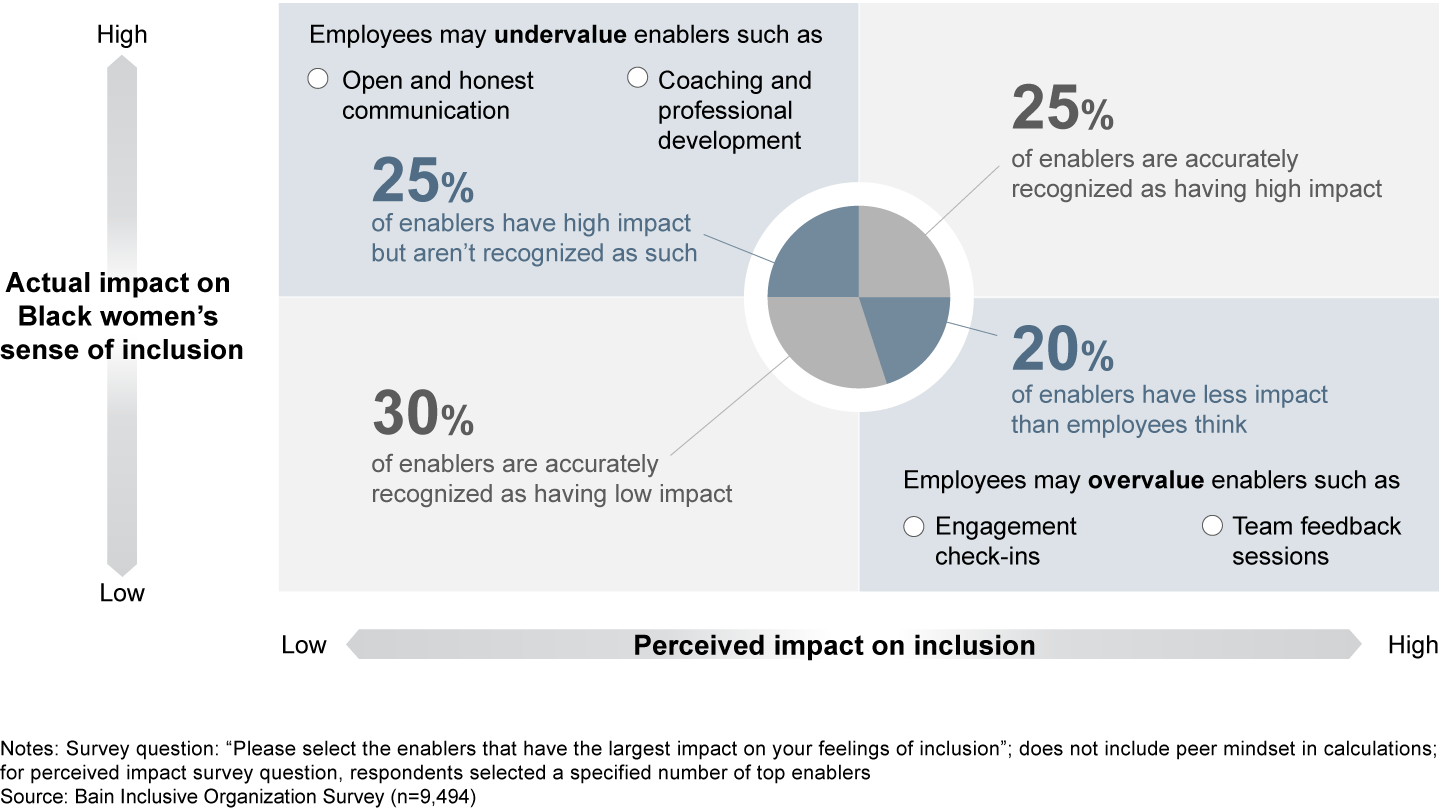
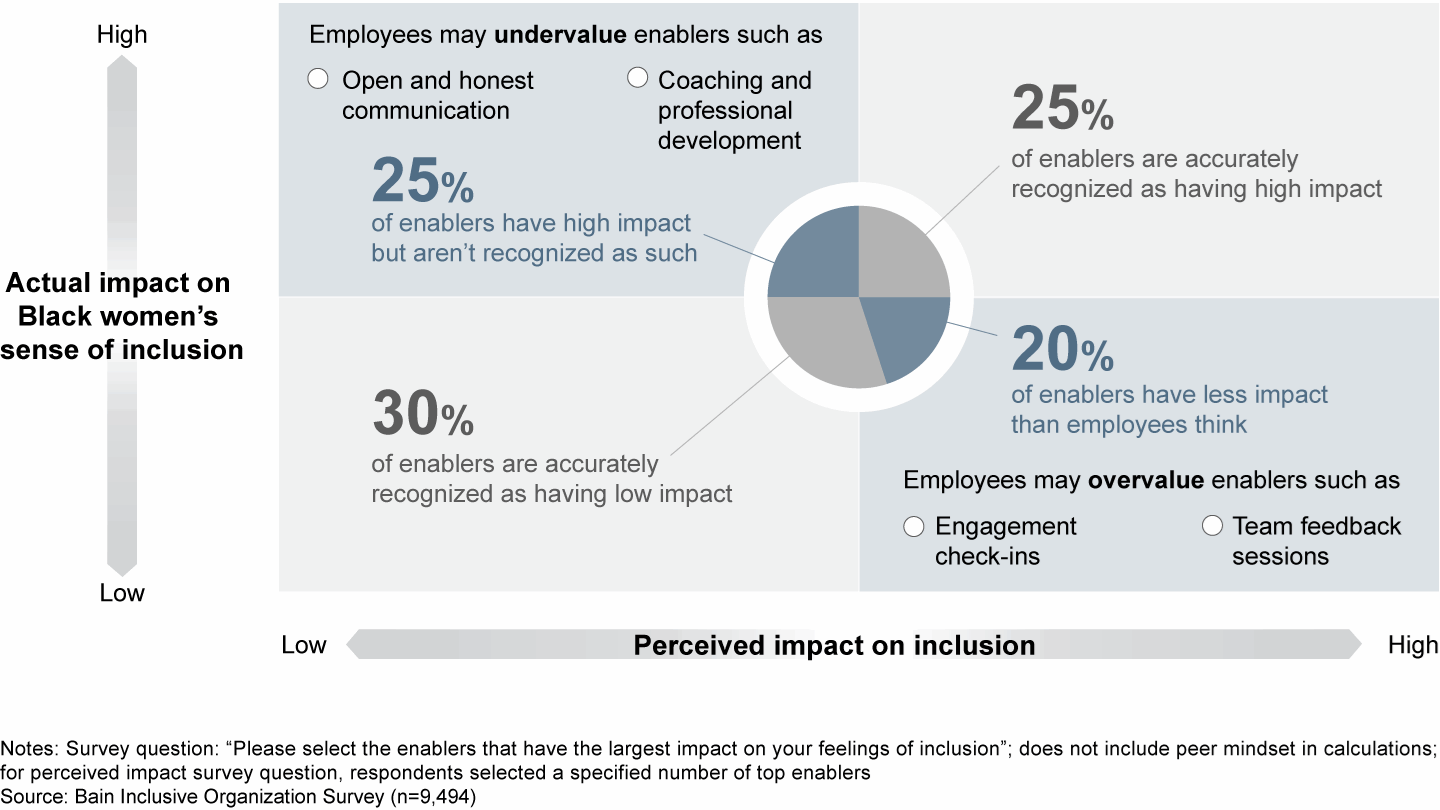
Cutting through the complexity
Because every demographic group has its own unique texture with respect to what enables members to experience inclusion, and because people do not always understand what precise actions will make them feel included, it can be complicated to sort out what makes inclusion real for a particular group. One piece of good news, however, is that there is a common denominator that boosts inclusion for virtually everyone: opportunities for professional development and growth (see Figure 8).

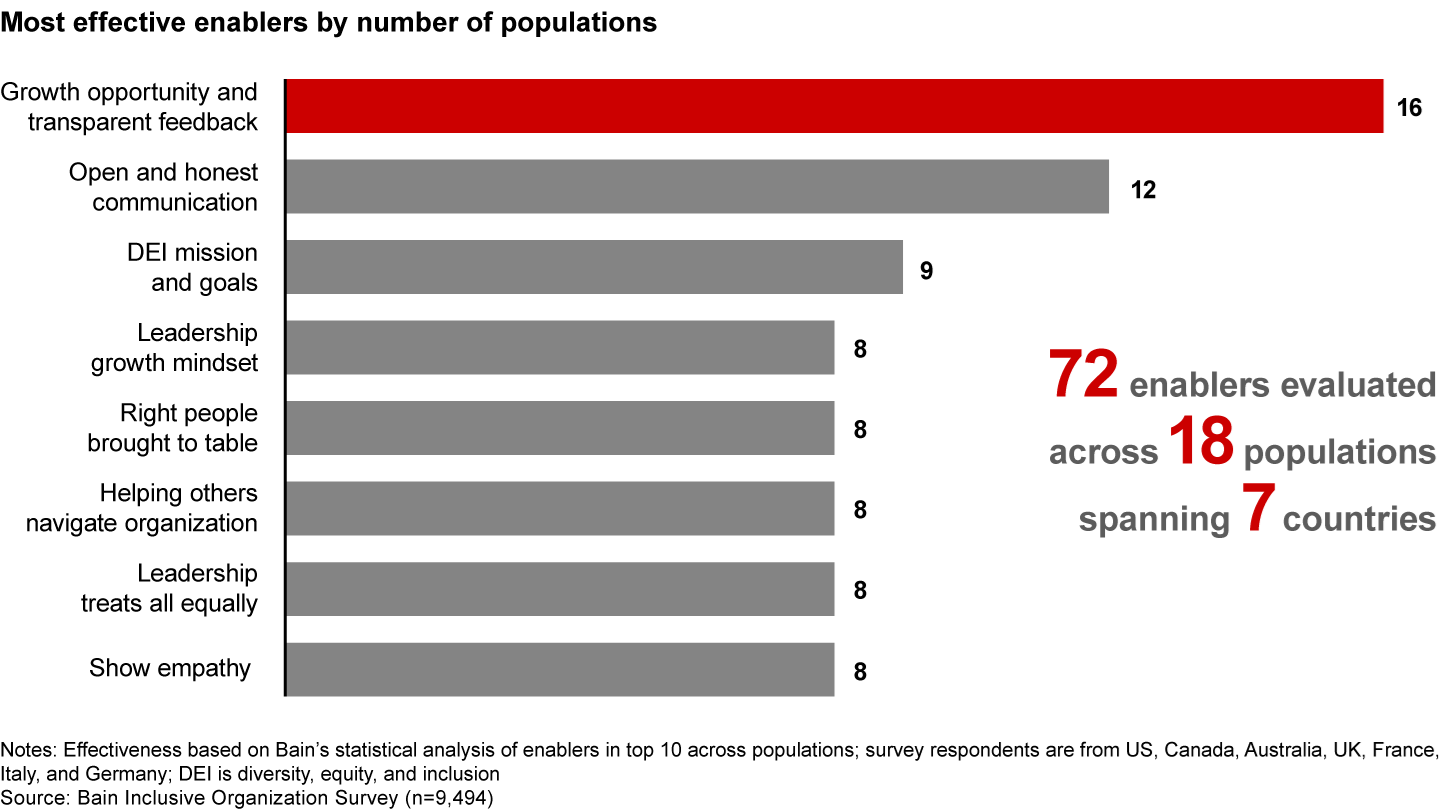
This still leaves a great deal of complexity for organizations to navigate. Because no single demographic variable cleanly predicts lower levels of inclusion in companies, targeting broad categories of people with reference to single factors is much too blunt a strategy for increasing feelings of inclusion. But there is a method for cutting through the complexity: looking at employees through an intersectional lens that incorporates geography, demographics, and seniority. Properly applied, this intersectional approach can show an organization where, and with what groups, it can take specific actions that will actually advance the goal of greater inclusion for all (see interactive below for a few examples of how this can work).
In identifying such actions, is it essential to note that employees’ feelings of inclusion are grounded in everyday experiences, which consist of their encounters with both the mindsets and behaviors of others and a company’s systems, structures, and processes—what we have classified as behavioral and systemic enablers, respectively. Our analysis, moreover, reveals a bedrock “hierarchy of needs” according to which almost everyone requires underlying systemic support to feel fully included, with people’s focus shifting to behaviors once systems more fully support them. It has also given us insights into some ways that geography, demographics, and seniority tend to influence the kinds of enablers that most increase inclusion for particular populations:
- Geography. Some Western European countries (France, Germany, Italy, and the UK, in our research sample) have more comprehensive workforce regulations—encouraging or mandating the creation of organizational systems that serve broad populations in more inclusive ways—compared with countries such as the US, Canada, and Australia. This baseline of supportive systems tends to make behavioral enablers a more important factor in increasing employees’ sense of inclusion in Western Europe.
- Demographics. Many organizational systems were designed with the majority population in mind, and therefore have unconscious biases embedded in them. Underrepresented populations often find that such systems do not serve them adequately, and therefore tend to benefit more from systemic enablers.
- Seniority. For junior employees, supervisors often are “the system,” and the latter’s behaviors tend to be the most important factors in these junior employees’ sense of inclusion. This tends to make behavioral enablers more effective for increasing experiences and feelings of inclusion among this group. More senior employees, by contrast, are often more focused on career progression and how the architecture of the organization helps or hinders their success—thus making their sense of inclusion more dependent on systemic enablers.
Weaving the fabric: Making inclusion a reality
Our findings tell us that creating genuinely more inclusive organizations, while challenging, is something companies can actually do. Moreover, organizations that want all their people to feel included need not—and indeed cannot—rely on some combination of lofty aspirations, sincere intentions, and the right messaging. Real, sustainable change comes from doing. Making a more inclusive organization is about employees—and leaders—throughout the organization adopting new mindsets, changing behaviors, and learning to operate in and adapt to new and different systems. Agile methods of testing and learning, along with repeated practice, are key to making this happen.
“DEI mission statements can be lip service; without real action, it won’t help me feel included at work.”
People are looking to see if their organization understands and cares about their unique needs for inclusion and is prepared to make a real commitment to addressing them. Meaningful analysis, authentic listening, visible action, and feedback are all key to demonstrating deep commitment. In practice, this means starting out by understanding the organization’s current state, establishing its ambitions and goals, and developing an inclusion game plan that prioritizes target populations for specific initiatives and sets up a leadership team with clear roles and responsibilities for execution.
Our research—and particularly our findings on the centrality of success and growth opportunities for all groups—suggests a few basic priorities organizations should then act on right away. While these steps are challenging in themselves, our data suggests that organizations can employ them effectively even while taking stock of the current state of inclusion and formulating longer-term goals.
- Signal commitment. Clear goals, by themselves, increase feelings of inclusion for many groups. The first step is often showing people that inclusion is truly important to leadership—for example, by articulating concrete diversity, equity, and inclusion (DEI) ambitions and goals and communicating them clearly across the organization.
- Promote growth. Because access to growth opportunities and career advancement are consistently strong enablers of inclusion across all populations, immediate actions might include: installing stronger rituals around professional development and coaching, training leaders on growth mindsets and team development, and introducing effective sponsorship and mentorship programs that help people navigate the organization.
- Facilitate connection. People feel more included when they have support—both from peers who share their identities (and challenges) and from allies. Early steps here might include expanding employee affinity group offerings, developing programming to help underrepresented employee groups find one another and bond, and promoting networks of allies (see Figure 9).
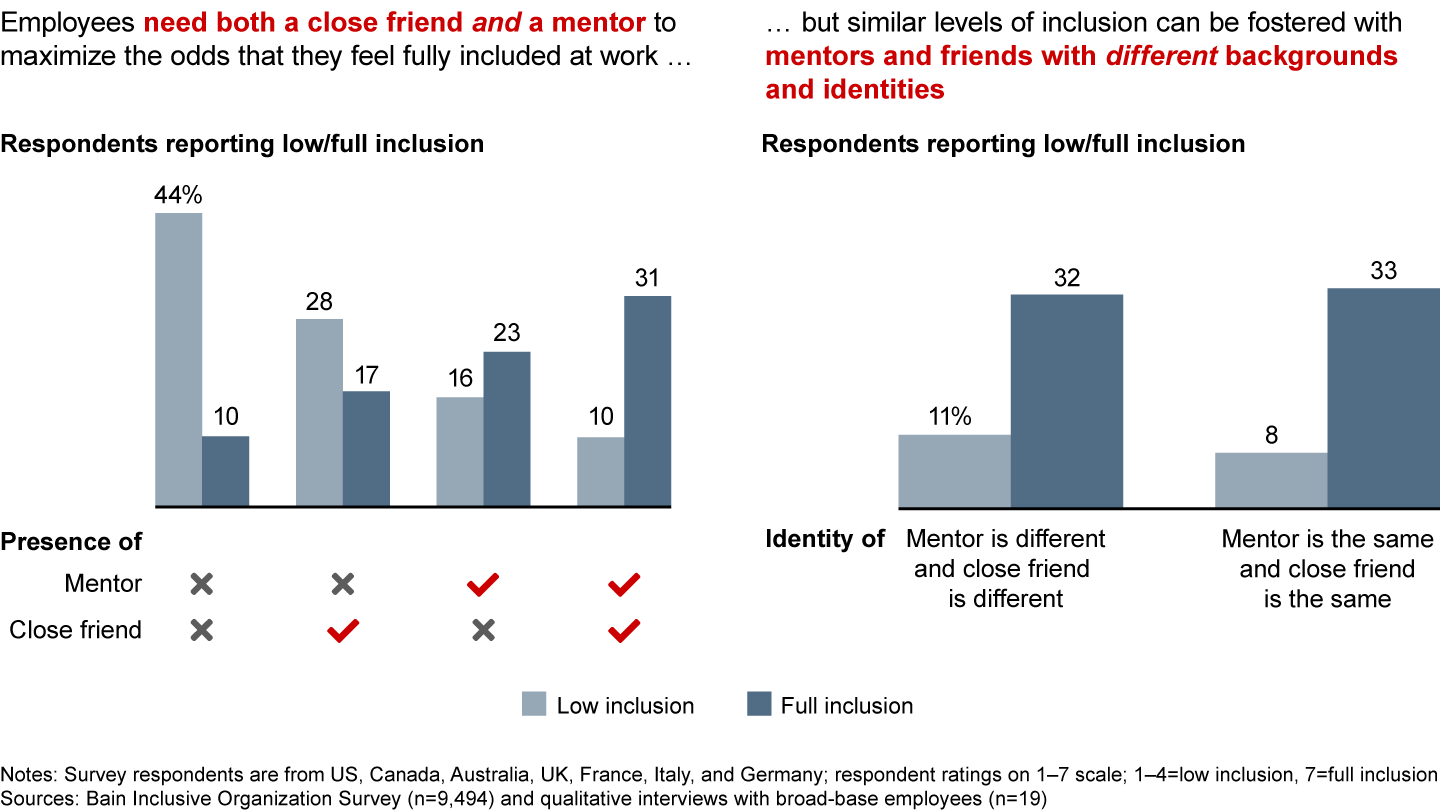

After an organization has attended to these cross-cutting initial priorities, the journey quickly requires more rigor and focus. We believe that a practical—and effective—approach to becoming more inclusive will be based on a few key principles:
- Focus on intersectionality. Creating inclusion for people requires accounting for the many identities people have both at and away from work, and the interplay among them.
- Use data and narratives to formulate answers that will inspire change. Data can provide a “single source of truth” to align leadership on the right path forward, while real-life stories of lived experiences can touch hearts in an organization and motivate collective change.
- Identify the behavioral and systemic changes needed. Employee experiences are affected by their relationships not just with colleagues but with the company itself.
- Prioritize and customize your roadmap. Every company will have unique “bright spots” and “blind spots”; focusing first on groups in the organization that have the most to gain, and building momentum through actions that will actually increase inclusion most for those groups, are ways to start setting priorities and addressing an organization’s particular needs.
- Focus on doing, not just explaining, to bring about sustainable change. People learn and retain their ability to change through real-life practice and coaching (rather than reading about best practices).
We have called inclusion a fabric because it is something woven of diverse strands that retain their individual integrity even while being part of a whole. It is also a fabric in the sense of an underlying structure, a framework in which people in the organization, and the organization itself, can do their best work when the structure is sound. It is about how people feel, but also about the design and the workmanship that creates a texture in which they can belong and feel supported—by being respected, able to be themselves, able to contribute, and able to be connected.
Weaving the fabric of belonging, then, is work for both the heart and the head. Done successfully, it makes both people and organizations better by making inclusion not just something we talk about but something we live—thus bringing us all closer to realizing our potential as both diverse individuals and members of teams.
This report would not have been possible without the valuable research, analysis, writing, and editing support of many colleagues: Ruchi Singh, Dylan Joyce, Ronnie Westmoreland, Jesse Wilkinson, Somtochukwu Dimobi, Tiffany Chiang, Colleen Lin, Regina Ceballos, Dawn Kix, and Aimee Caffrey. The authors thank them for their important contributions.
Net Promoter®, NPS®, and the NPS-related emoticons are registered trademarks of Bain & Company, Inc., Satmetrix Systems, Inc., and Fred Reichheld. Net Promoter Score℠ and Net Promoter System℠ are service marks of Bain & Company, Inc., Satmetrix Systems, Inc., and Fred Reichheld.